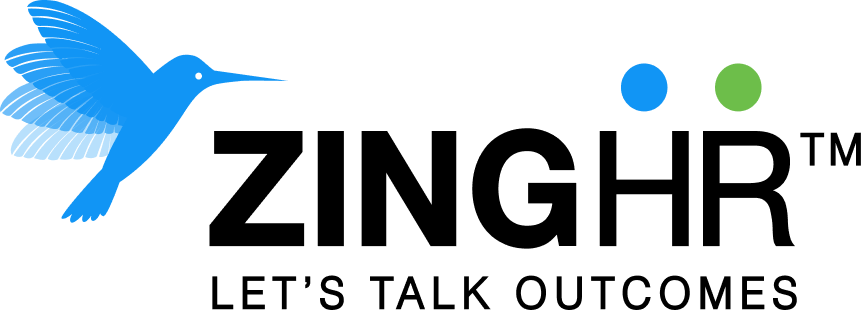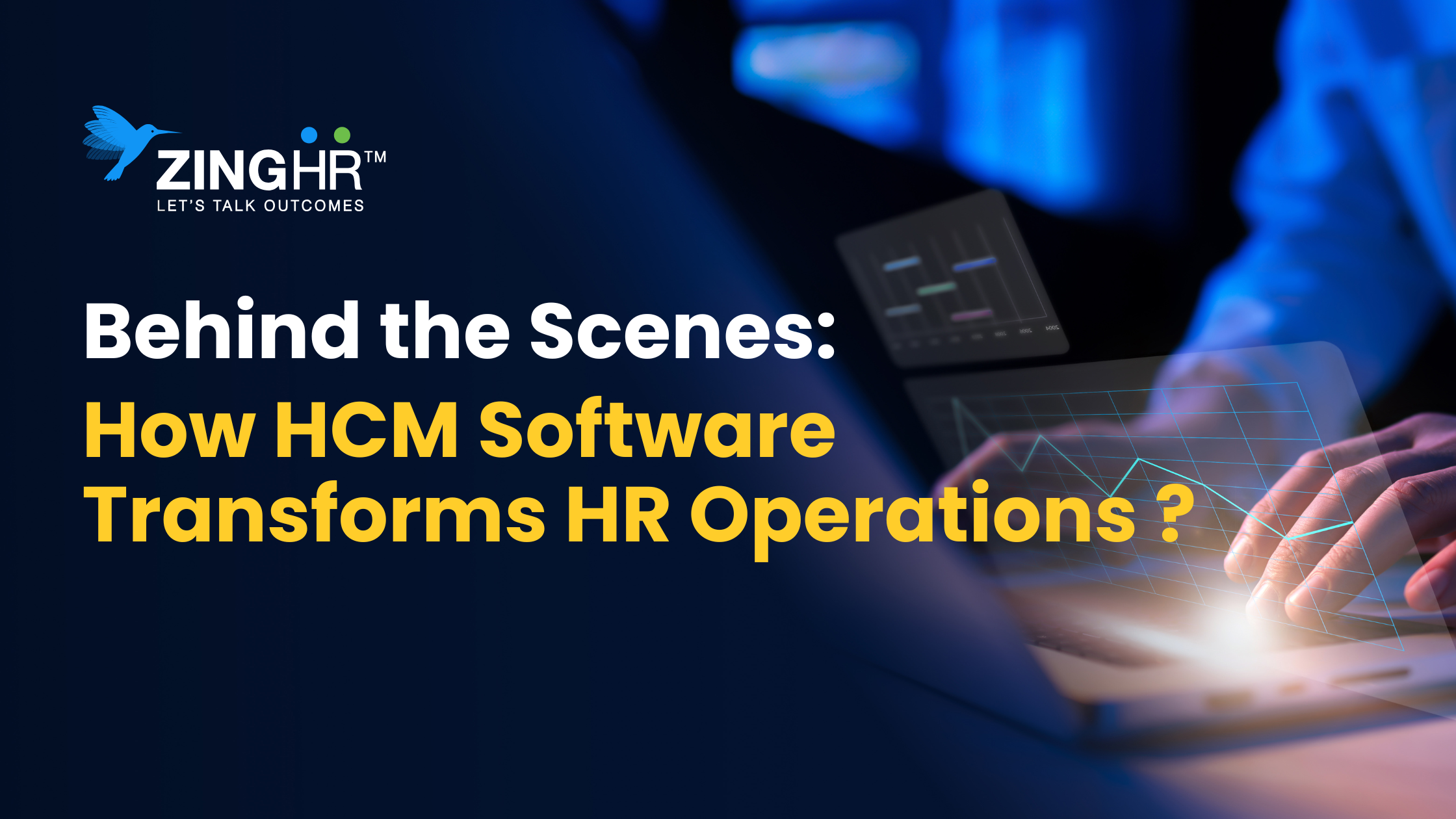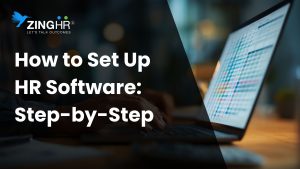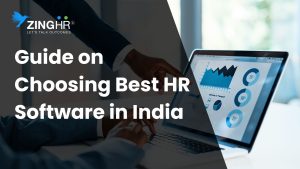What Are the Functions of HCM?
Human capital management (HCM) is a strategic approach to traditional Human Resources Management (HRM). HCM covers the functions of HR, such as hiring, onboarding, and payroll, as well as strategic areas such as talent development, performance management, succession planning, employee engagement, and compliance.
How HCM Software Works
HCM software aims to simplify HR processes. It utilizes AI and analytics to automate repetitive tasks, store employee data digitally, provide self-service portals, streamline recruitment, manage payroll and attendance, and support data-driven HR decisions.
Modern HCM software uses advanced technologies that enable you to analyze past data to derive patterns and insights, access automated, personalized recommendations, predict workforce outcomes, and track the real-time progress of tasks.
How does HCM software work? Let’s understand the most important HCM roles below.
1. The Digital Backbone of HR
HCM digitizes HR to give it a modern spin, appeal to the younger generation, and guarantee data security and management. It is a central repository of all employee data, including recruitment figures, performance metrics, training effectiveness, and even engagement scores.
As the digital upper hand of HR, HCM automates functions such as recruitment, learning, and performance evaluation. It brings fairness and accessibility to processes, ensuring employee trust and satisfaction.
Coupled with analytics, data insights, self-serving dashboards, and compliance tools, HCM systems cultivate a promise of future-ready, resilient, and adaptable HR and workforce, ready to face challenges as they come.
2. Behind the Screens
HCM software supports a range of features and improves them with automation. Embedded with AI, real-time data analytics, and automation, these digital platforms speed up processes and make HR processes seamless. For instance, companies can deploy chatbots to answer candidate and employee queries. Moreover, AI can roll out personalized recommendations for employees’ learning paths.
Using an HCM system, employees can easily access their leave balance, goals, upcoming training sessions, team hierarchy, and documents in one place. In fact, HCM software also makes onboarding and resigning simple and quick, enabling employees and HR executives to initiate actions with just a few clicks.
3. Inside the HCM Engine
So, how does HCM software work? At its core, HCM creates a unified HR flow, from recruitment to retirement. Instead of switching between different tools or systems, HR teams can manage sourcing, hiring, onboarding, training, and performance from a single dashboard.
These smart workflows are a boon to employees and HR teams, allowing them to spend less time on administrative tasks and more time and thought on the strategic tasks at hand.
Moreover, most HCM systems can be easily integrated into your company’s existing software. They connect several functional areas to present a one-stop solution for all things HR. This ease of integration cuts down the setup time and ensures the workflow runs normally.
4. From Manual to Magical
Manual paperwork and time-consuming processes have tarnished the HR department’s image for too long.
HCM is here to rebrand this image.
It simplifies hiring with automated screenings, onboarding with digital documentation, engagement with regular two-way feedback, and performance management with targeted, achievable goal-setting. Automated talent management and development is also a key HCM function, creating personalized learning modules and career growth charts for employees at all levels.
Furthermore, HCM software automates HR payroll with digital compliance, real-time attendance tracking, and performance analytics. Real-time insights and recording ensure error-free payroll, no matter your company’s payment cycle—daily, weekly, or monthly.
5. HCM Software Demystified
At the core of HCM software is data. It drives the entire software, whether you’re accessing it on its website or app. HCM systems collect, analyze, and categorize data on hiring, performance, engagement, retention, attrition, and everything else. Then, the platform extracts useful insights from all this data to inform HR decisions of all kinds.
Thus, in essence, HCM is nothing but a data-led, digital, and more strategic version of traditional HR. It does not jump too far away from its core meaning; it just pushes HR to evolve.
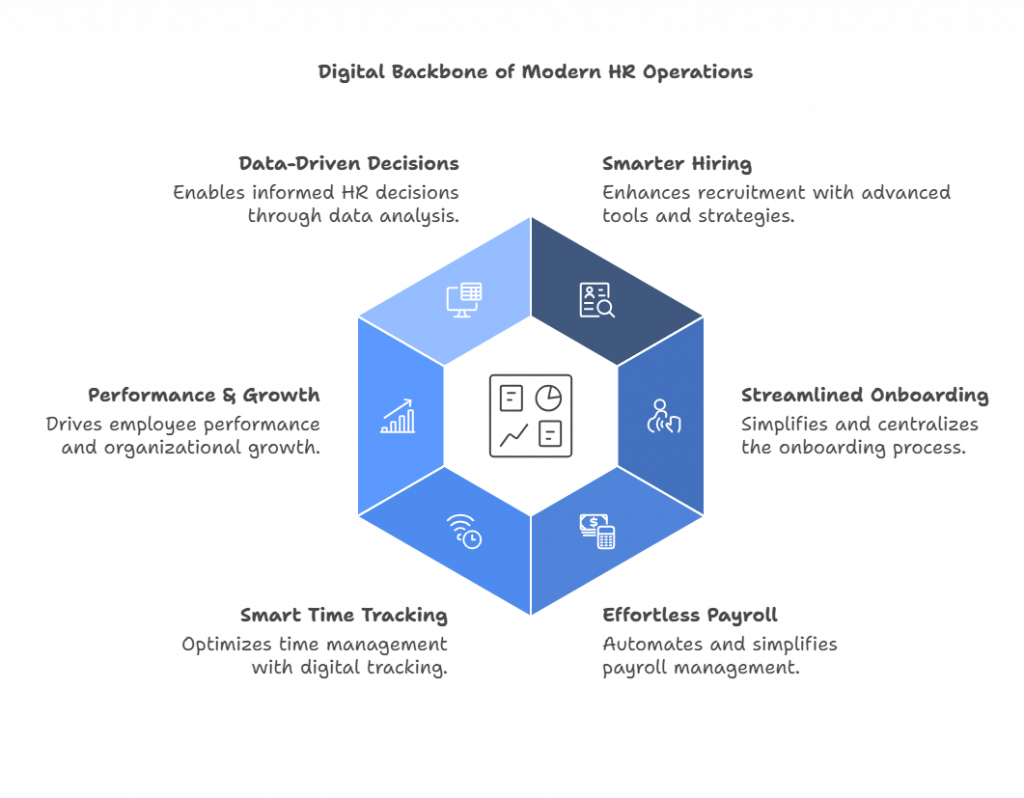
Strategic Functionalities of HCM Software
HCM software caters to the functional areas of HR with a strategic mindset, elevating them beyond the everyday employee-centric issues and to the business’s long-term success.
Are you still wondering, “How does HCM software work?” The following are the key functionalities of HCM roles:
1. Performance Management
HCM software makes performance management more consistent, transparent, and data-driven. The system helps minimize human bias in evaluations.
The performance management feature within HCM software supports the objectives and key results (OKR) method and sets up regular goal-setting periods with managers. It also provides suggestions for personal and professional goals, their achievable timeframes, and the steps that employees can take to achieve their goals. At the end of the goal period, the results are compared against both standard and individual key performance indicators (KPIs) to assess efficiency.
Using these insights, managers and HR executives can reward quality performers and provide direction to those who need to improve.
2. Learning & Development
A workforce that regularly gets trained with new concepts and industry trends is vetted to excel and lead organizations. HCM software understands the significance of learning, which is why it recommends and builds personalized learning paths for employees.
With HCM, individuals can easily access recorded training modules on their self-service portal. This way, employees don’t have to sit through hours of training in uncomfortable seats; they can simply watch bite-sized modules and videos between tasks or during breaks.
Moreover, companies can partner with educational institutes or universities to build integrated learning modules, which would be available for employees for free on popular e-learning platforms.
3. Succession Planning
Business success, whether present or future, depends on high-performing talent, those who are aligned with business values and committed to its big-picture vision. HR leaders often want to assess and identify these quality employees in their early months at the company to train and nurture them for critical leadership roles.
HCM software supports this by using performance insights to highlight consistent top performers. By identifying these individuals early on, managers and directors can prepare them to take on bigger responsibilities and, ultimately, join future leadership.
AI-based HCM platforms can chart these employees’ career paths, including goals to achieve, skills to learn, and specific tasks to accomplish. It makes it easier for them to visualize their future at the company, including the position and the compensation, and work with increased motivation.
4. Workforce Analytics & Reporting
Real-time dashboards and predictive analytics offered by AI-powered HCM systems enable robust workforce analytics.
HR can take one look at employee dashboards or utilization charts to assess real-time workload distribution and optimize it properly. It is also possible to view complex data in easy-to-understand visuals to extract insights.
Predictive analytics can help HR predict upcoming attrition based on disengagement and other factors, possible challenges and their solutions, and future workforce needs. This data-driven information helps HR make smart decisions and prepare better for the future.
5. Employee Engagement Tools
Disengagement is among the top reasons people leave their jobs. In fact, disengaged employees are 2.5 times more likely to quit than engaged employees. Thus, employers must encourage engagement initiatives proactively, not as a result of a demotivated, unproductive workplace or an increasing attrition rate.
Through an HCM platform, organizations can circulate digital surveys and feedback forms among employees to let them know that their opinions matter. These surveys should be quick to fill out and include some open-ended questions to provide space for detailed answers. The answers obtained can be used to calculate the engagement score, which should be updated regularly to take the necessary actions to engage the workforce.
8 Ways ZingHR HCM Software Simplifies Your Entire HR Processes
Packed with modern features, easy integrations, and strategic benefits, an HCM platform can boost your HR efficiency and effectiveness. Among the top names for HCM solutions providers is ZingHR. Our suite of HCM roles and services can automate and streamline your functions of human resource management from day one. Let’s understand these solutions in detail.

1. Talent Acquisition and Recruitment
The right talent sets the standard for future hiring expectations and the tone for ongoing business success. Recruitment is the core of HCM’s functional areas. From automated sourcing and screening to interviewing and budgeting, HCM platforms manage everything.
ZingHR offers the following features to help you recruit talent systematically and promptly:
- Applicant tracking system (ATS)
Automate job postings, resume screening, and candidate tracking with the ATS. Let the tool filter profiles based on keywords, skills, and qualifications that your job vacancies require. Maintain swift communication with candidates and access key metrics and analytics on hiring.
- Manpower planning and budgeting
Estimate the number of employees required currently and in the future in every department or for a new project. Let the platform consider the current employee budget and calculate the budget for new hires.
- AI robotic interviews
Access AI-generated interview questions specific to the position, run multiple parallel human-less interviews, and record assessments and emotion analysis. Reduce interview time by 95% and receive an objective, bias-free interview assessment.
- Industry-agnostic hiring
Whichever industry you are hiring for, ZingHR can accommodate high-volume and urgent demands. Create video job descriptions for individual and bulk hiring and get salary benchmarking insights.
- Candidate intelligence
Access AI-powered candidate recommendations, create a talent pool for the future, and receive analyzed fitment scores for each candidate. Store detailed candidate profiles, along with their skills, experience, and qualifications.
- Flexible workflows
Select the hiring stage you are at to receive custom support. Choose from effective workflow templates, easily track progress, customize your workflow according to your needs, and integrate it with your current software.
2. Onboarding
A welcoming, engaging, and standardized onboarding procedure—for both in-office and remote hires—makes them feel like they made a smart decision by joining your company. It sets the tone for how well they will be treated at your organization.
ZingHR digital onboarding with these features:
- Digital document management
Store, send, sign, and collaborate on documents digitally to access them whenever you need. These could include employees’ references, background check reports, standard onboarding materials, orientation training documents, etc.
- Virtual onboarding workflows
Try ZingHR’s paperless onboarding process, automate offer sending and acceptance, communicate with candidates through the candidate portal, and access the platform through the mobile app for enhanced ease.
3. Employee Data Management
Much of employees’ time is spent on finding files in cluttered storage systems. On top of that, if files are not synced on a cloud storage system, they easily get lost, affecting project timelines and accuracy.
With ZingID, an enterprise blockchain network-based document management system, you can solve this issue through:
- Centralised employee records
Looking for employee profiles, performance records, training completion records, and feedback in different folders or platforms? Set up ZingID—it creates a secure central repository of everything you may need to know about an employee.
- Document storage and retrieval
Upload important documents, including transactions and compliance reports, on ZingID’s cloud-based digital locker. The tool keeps documents secure, even password-protected if needed, and allows only authorized personnel to access them.
4. Zero Touch Payroll
Accurate and timely payroll is what employees look forward to every pay cycle. Incorrect or delayed payment may make them demotivated and lose respect for the company.
ZingHR’s Zero Touch Payroll lets you account for both full-time and gig workers’ compensation with these components:
- Easy compliance
Comply with local and international (in the case of remote workers or a geographically spread business) laws to pay employees fairly and promptly and avoid legal liabilities. Digital compliance considers the latest updates in regulations and minimizes the scope of manual error.
- Real-time reconciliation
Payroll errors are common, but they don’t have to be with Zero Touch Payroll. If an error occurs, even with minimal chances, you can rectify it in real time. With just one click, the tool analyses the recorded data and makes the required changes.
5. Time & Attendance Management
A mismatch in punch-in and out times leads to inaccurate HR payroll, which is often the case with manual record-keeping. When attendance is punched manually and reconciled at the end of the pay cycle, not in real time, errors are bound to occur and bring chaos to the workplace repeatedly.
ZingHR’s digital, real-time time and attendance management solution guarantees accurate records in terms of:
- Shift scheduling
View the entire organisation’s real-time attendance in one view to see who is working on which shift. Schedule shifts based on employees’ locations and availability. You can also allow flexible shifts if employees need them.
- Leave management
Employees can view their leave balance and apply for leave with just a few clicks on the ZingHR HCM system—no need for emails that ask for approval from multiple entities. HR personnel or managers can approve or reject leaves through the software.
- Attendance tracking (biometric/face recognition)
Eliminate multiple hardware and proxy attendance punching by using our face recognition system. Detect multiple faces in one go to save time and record real-time attendance with 95% accuracy.
6. Talent Management
A crucial part of employee retention efforts is talent management. Unless you properly evaluate, reward, develop, and promote your talent, they will likely not want to stay with your company.
At ZingHR, you are promised a holistic approach to talent management with the following elements:
- Collaborative goal-setting
Set goals for each employee based on their competencies, role, and career and growth aspirations. Use data and predictive analytics to determine the goal completion period. Establish key performance indicators (KPIs) and key result areas (KRAs) to gauge results against goals.
- 360-degree feedback
Include both appreciative elements on a job well done and constructive pointers on improvement areas to make the feedback meeting effective. Ensure managers deliver data-backed feedback to avoid bias in performance evaluations. Maintain digital records of each feedback sent and received for future reference.
- Succession planning
Prepare internal talent for roles with higher responsibilities, thereby eliminating external hiring costs. Sustain business legacy by identifying and mentoring high-quality performers to take on the leadership reins.
- Learning & training
Design, deliver, and track online courses on Zing Learn. Enable employees to access modules and materials whenever they want and complete learning at their own pace, whether in one go or multiple micro-learning sessions. Track progress in real time and provide support when needed.
7. Workforce Management
HCM systems like ZingHR bring all functions of workforce management under one roof. Payroll, work allocation, attendance, employee well-being, or compliance—whatever you need to focus on, you can access through one single platform.
ZingHR handles all this and more to simplify HR for you and your employees:
- Employee lifecycle
Hired a new employee? Add their details to the software and create a new employee profile in minutes. Manage the entire employee lifecycle in one profile view. Whether you need to transfer them, send signed offer letters, confirm their employment post-probation, or accept their resignation, do it all on one platform.
- Digital organograms
An organogram, or organization diagram, displays your company’s hierarchy. New hires can refer to the digital organogram to know who they should report to, their team members, and the communication hierarchy. It is also possible to open full employee profiles by just clicking their names/pictures.
8. Actionable HR Analytics and Insights
Decisions based on intuition and assumptions are a thing of the past. Today, if you are not utilizing real-time data analytics and insights to make decisions, your organization may suffer losses in terms of finances, clients, and talent.
ZingHR’s Power BI-led metrics and analytics can assist you with the following:
- Real-time dashboards
See real-time employee availability and any changes to shift scheduling. Let employees view their attendance, leave balance, holidays, projects, team members, and more information in one dashboard.
- Predictive analytics for workforce trends
AI-driven predictive analytics helps you estimate future workforce needs in different business locations based on current and upcoming projects. It also helps you create job descriptions, source candidates, and budget for new hires. Predictive analytics is also helpful in identifying employees who are likely to leave, so you can plan to engage and retain them.
- Data-driven decision-making across all HR functions
Access industry trends, workforce metrics, and real-time business data through ZingHR’s HCM system’s analytics and tools. Use data as the foundation for important decisions regarding hiring, talent management, policy-making, workforce management, etc.
Try ZingHR – The Ultimate HCM Software for Your Business
In essence, HCM systems digitise and automate the functions of human resource management to save HR time, improve efficiency across the organization, deliver a smooth employee and candidate experience, and foster a data-driven culture. ZingHR’s powerful HCM suite is great for all kinds of organizations, whether you’re setting up a new system for the first time or scaling your HR functions across countries. Request a consultation today to experience the ‘power of one’!
